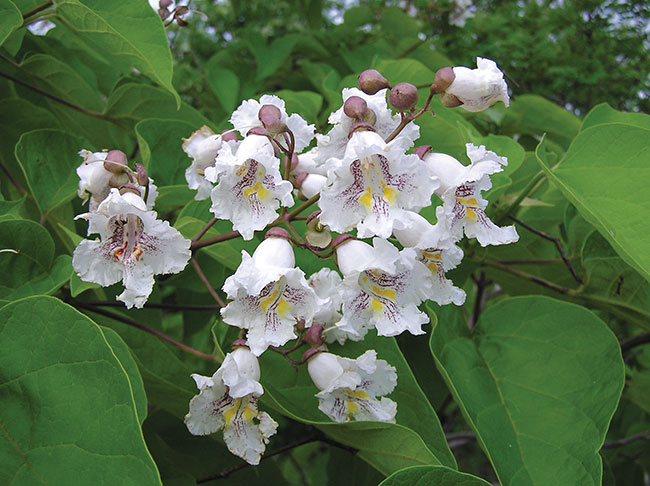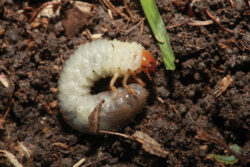
Features
Agronomy
Turf Revival
Plants are talking: Are you listening?
Plant phenology serves as a reliable indicator of environmental conditions and biological processes
March 13, 2024 By Dr. Sara Stricker & Dr. Katerina Jordan
 Catalpa flowering.
Photo credit: GTI
Catalpa flowering.
Photo credit: GTI You might think you know your local landscape like the back of your hand, but have you been listening to what the plants are telling you? Amidst our daily turf management tasks of mowing, watering, and fertilizing, there’s a subtle language being spoken – one that often goes unnoticed but holds valuable insights into what is happening within the ecosystems.
We call this language plant phenology; the timing of plant lifecycle events such as budding, flowering, and fruiting. There is an intricate relationship between turfgrass insect pests and environmental conditions, and we can use the silent cues that nature provides to better protect our turf.
Plant phenology serves as a reliable indicator of environmental conditions and biological processes. From the emergence of buds in spring to the shedding of leaves in autumn, each phase of a plant’s lifecycle reflects the interaction of temperature, moisture, and daylight hours. By observing these subtle shifts, we gain a deeper understanding of the rhythm of nature and the ecological dynamics at play.
In the context of turfgrass management, plant phenology offers valuable insights into the timing and intensity of insect pest activity. By paying attention to these phenological cues, caretakers can anticipate pest outbreaks, implement preventive measures, and minimize the impact on turfgrass health. Think of it as your crystal ball for predicting insects!
Several insect pests pose significant challenges to turfgrass health, each exhibiting distinct phenological patterns that coincide with specific stages of plant development. For instance, the lifecycle of white grubs – the larval stage of various scarab beetles – can be predicted using plant phenology.
One indicator for the emergence of Japanese beetle adults is that the morning glories and linden tree have begun to bloom. As these beetles lay eggs in the soil, their offspring hatch and begin feeding on turfgrass roots, reaching peak activity during the warm summer months. If you see plenty of adult beetles, you know that the white grub infestation is coming soon after.
Likewise, the lifecycle of the European chafer beetle can be predicted by the blooming of Vanhoutte spirea, which indicate when the larvae are going into the pupal stage.
Aeration and removing excessive thatch can improve the overall health of your turf, and there are several biocontrol products containing beneficial nematodes, bacteria, or bacteria which are sold for the control of white grubs. To maximize the efficacy of a biocontrol product, always read the label carefully, and reapply as recommended. The best time to target white grubs is when they are small – so we can listen to the local plant for the reminder notifications they are sending! Set your clocks: approximately four weeks after linden tree bloom is a good time to target white grubs. But if the Vanhoutte spirea has begun to bloom, then you’ve probably missed your chance to manage white grubs for this season. Rescue missions in early spring and late fall when the grubs are large and causing intense damage is often frustrating and can make you feel hopeless. Understanding the lifecycle of this pest and using our tools with precision is the best management practice.
Another example is how you can predict the onslaught from hairy chinch bug by looking for birds’ foot trefoil. These yellow flowers typically pop up at the same of time of year that most of the chinch eggs have hatched, so you can start your scouting efforts for the first nymphs. Identifying pests early enables prompt intervention before they cause significant damage to the turfgrass. Some management recommendations for chinch include raising the height of cut, watering deeply, and check your local legislature to see if the biocontrol containing Beauvaria bassiana is available in your region.

White grubs are the larvae of Japanese beetles, European chafer beetles and June beetles.
Photo credit: GTI
Forsythia blooming in early spring is a nice reminder for us to put down our spring fertilizers. It also talks to the golf course superintendents; these yellow blooms signal the migration of annual bluegrass weevil. The overwintering adults will emerge and begin their march towards fairways and greens, where they will mate and lay eggs. When the Forsythia flower petals have dropped, this is when the larvae have begun to feed, and the damage will soon be evident. This signal is a cue to turf managers to put down an insecticide which will target the early life stages of the pest.
By monitoring plant phenology and understanding the lifecycles of these pests, caretakers can implement targeted control measures at critical stages, reducing the need for rescue interventions. And if you find yourself in a situation where you do not have any of the indicator plants mentioned, you can do one of two things: you can plant them on your site so that you have those little reminders, or you can try to observe other plants that are blooming near your turf when you first notice the presence of various species of insects and then look for those phenological indicators each year.
Overall, fostering healthy turfgrass ecosystems through proper cultural practices such as soil aeration, irrigation management, and overseeding will enhance plant resilience and reduce susceptibility to insect pests.
And remember to listen to what the plants are saying! In our local landscapes, we need to keep our head on a swivel to look for and decode the silent cues being sent to us from the nearby plants. By listening attentively to the language of plant phenology, we can gain valuable insights into the timing and intensity of insect pest activity, empowering us to implement proactive and sustainable management practices.
Dr. Sara Stricker is communications and outreach co-ordinator at the Guelph Turfgrass Institute. Dr. Katerina Jordan is director of the Guelph Turfgrass Institute.
Print this page